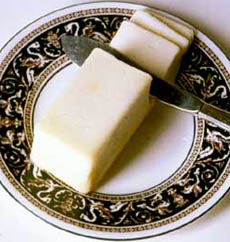Butter Glossary: A Glossary Of The Different Butter TypesPage 7: Butter Glossary T To Z This is Page 7 of an 8-page article. Click on the red links below to visit other pages. This glossary is protected by copyright and cannot be reproduced in whole or part. You are welcome to link to it.
|
 Butter photo courtesy of Vermont Dairy. |
|
| TABLE CREAM or COFFEE CREAM Light cream, containing 18% to 30% butterfat. |
||
| TOCOPHEROL An antioxidant used to decrease the oxidative rancidity of fat or oil. A natural antioxidant, it improves oxidative stability. |
||
| TRUFFLE BUTTER Sweet butter mixed with black or white truffle peelings. The truffles provide rich truffle flavor and aroma, and the butter can be used with eggs, pasta, vegetables, rice, or simply enjoyed on bread. Read our review of D’Artagnan truffle butter. |
||
| USDA STANDARDS FOR GRADES OF BUTTER The U.S. Department of Agriculture (USDA) grades butter quality based on flavor characteristics and rates it according to body, color and salt. A final grade is assigned based on the combination of all four attributes. Grades include AA, A and B. All butter sold in the United States must contain at least 80 percent milkfat. |
||
| U.S. GRADE AA Most commonly found at retail, Grade AA butter is the finest (93 score), made from sweet cream and has a smooth, creamy texture. It is easy to spread and has a light, fresh flavor. It can be lightly salted. |
||
| U.S. GRADE A Grade A butter is the second best grade (92 score), and is often found at retail. Like Grade A butter, it is made from fresh cream, but has a slightly stronger flavor. It has a fairly smooth texture. U.S. GRADE B Grade B butter (90 score) can be used by consumers for table use, but is generally sold in bulk. It is usually made from sour cream and is more coarse in texture. |
||
| UNSALTED BUTTER This is butter that contains no salt and is sometimes erroneously called sweet butter (see sweet cream butter). It is generally preferred for cooking and baking since it enables the salt level to be adjusted according to the preference of the cook. However, unsalted butter is more fragile: salt is a preservative, and salted butter is less perishable. |
||
| VITAMIN A Butter contains about 3,000 IU of vitamin A per 100 grams, or 153 IU per serving (1 pat/ 5 grams). |
||
| WHEY BUTTER A specialty product made from the whey drained from cheese curds. It is strong and salty with a cheesy flavor. |
||
| WHIPPED BUTTER Butter which has had air or other acceptable gases (e.g., nitrogen) whipped into it, resulting in a product with greater volume, reduced density and improved spreadability at colder temperatures. Whipped butter typically is packed in tubs or cups. Whipping improves the spreadability of butter, but it should not be substituted for regular butter in baking. |
||
| WHITE SAUCE A term for light white or blond sauces. In its simplest form, white sauce is cream or milk mixed into a white roux (a combination of butter and flour which isn’t browned). This basic French sauce is called béchamel. See butter sauce. |
||
| WHOLE MILK Regular milk. Whole milk has close to 4% milkfat (butterfat). Go To The Article Index Above |
||
Last Updated Apr 2018
© Copyright 2005-2025 Lifestyle Direct, Inc. All rights reserved. All images are copyrighted to their respective owners.